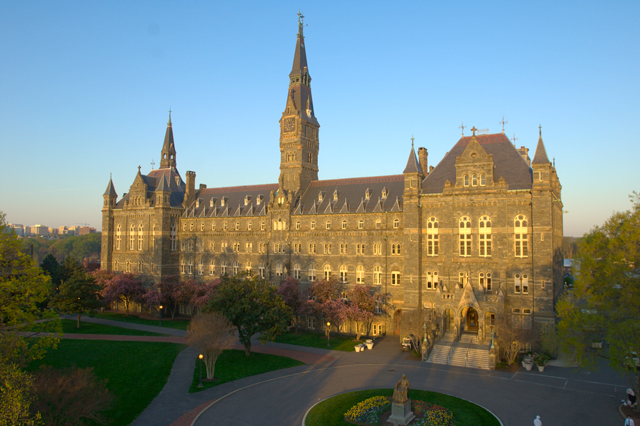Georgetown University, like many American institutions of its age, was built by immigrants. In a contemporary political climate defined by xenophobia, it is more important than ever to understand and spread this historical truth.
The story begins with the English Jesuits who established a colony at St. Mary’s, Maryland in 1634. These men, all of whom were immigrants, were the first to articulate the vision for American Catholic education that John Carroll would bring to fruition when he founded Georgetown in 1789. They are so central to the university’s identity that five of them––Andrew White, John Gravenor, Thomas Copley, Thomas Gervase, and Ferdinand Poulton––are memorialized through buildings on the Hilltop today. The buildings that carry their names are brick and stone reminders that the very idea of Georgetown came from immigrants.
The idea’s execution did, too. John Carroll’s great-uncle Charles Carroll was the first in his family to leave their home in Ireland, where civil wars had destroyed their wealth and oppressive laws had restricted their Catholic faith. When he set sail for Maryland in 1688, Charles Carroll changed the Carroll family motto from in fide et in bello forte (“strong in faith and war”) to ubicumque cum libertate (“anywhere so long as there be freedom”).
Over the next few decades, three-quarters of Charles Carroll’s young relatives followed him from Ireland to Maryland, including John Carroll’s father, Daniel. Georgetown’s founder was thus the progeny of a family with a quintessential immigrant story––one defined by many of the same hopes, fears, and sacrifices as those of immigrant families today. To the beleaguered Carrolls, as to my own immigrant great-grandparents, America held an extraordinary promise: the ability to live on one’s own terms, free from the oppressive social and economic divisions of the Old World.
After the English Jesuits inspired Georgetown and the Irish Carrolls founded it, a group of French priests ran the university in its first decade. The group included Jean Edouard de Mondesir, a French emigré who became Georgetown’s first professor in 1791, and Louis Guillaume Valentin DuBourg, another French emigré who became Georgetown’s president in 1796. After DuBourg, at least four more immigrants served as presidents during the university’s first century.
There are myriad other immigrants whose contributions to Georgetown deserve mention. Charles Liebermann, a Jewish emigré from Russia, founded Georgetown’s Medical School in 1849. George Kober, an emigré from Germany who arrived in this country as an unaccompanied minor, served as dean of the medical school for three decades in the early twentieth century. Léon Dostert, another unaccompanied minor who came to the United States as a French refugee from World War I, founded the institute that would become Georgetown’s School of Languages and Linguistics in 1949.
These men were only able to serve and lead Georgetown so nobly because they were first able to become Americans. But Liebermann, who was a member of a feared religious minority, and Dostert, who was a refugee from a foreign war, are precisely the types of immigrants now targeted by Donald Trump and his xenophobic rhetoric. If Trump’s desired policies had been in place in the nineteenth and early twentieth centuries, it is very possible that both men would never have made it to Georgetown at all. The same is true of John Carroll, a member of another religious minority whose father came to this land through chain migration.
Trump and his supporters might point out that they are not opposed to immigration from the places in which Georgetown’s founders originated, all of which are in Europe. But history makes clear that xenophobia evolves to find new targets in each generation. Irish Catholics like Carroll and Russian Jews like Liebermann were the Muslims and Mexicans of past generations, feared and reviled for their otherness. Their success in becoming fully American and contributing to this country’s institutions was achieved in spite of the obstacles that Trump’s ideological ancestors placed in their way.
The university’s recent efforts to support undocumented immigrants, which have included a statement of solidarity by President DeGioia, the creation of the Undocumented Student Task Force, and extensive lobbying efforts on Capitol Hill, are noble in their own right. But they possess even greater moral potency when considered against the backdrop of Georgetown’s history, which reminds us that immigrants have always brought with them an ingenuity, unique perspective, and abiding commitment to the American project that has made our society incalculably richer. DeGioia should talk about that history when he talks about immigration––because the story of the Carroll family, like that of Liebermann, Dostert, and all the immigrants who built Georgetown, is a powerful rebuttal to those who so wrongly and loudly claim that immigrants threaten us.
As we consider what it means to be part of the Georgetown community, as we consider what it means to be American, and as we enter the voting booth this November, every Hoya should remember Georgetown’s immigrant roots. They powerfully define who we are and who we are called to be.




